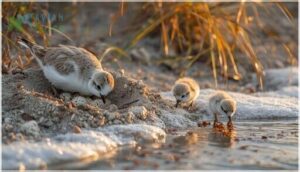This site is supported by our readers. We may earn a commission, at no cost to you, if you purchase through links.

But camouflage can’t shield it from bulldozers or rising tides. If you’ve ever wondered how wild freedom survives on crowded shores, the piping plover’s story offers answers. From nesting battles to migration marathons, every detail reveals what it takes to keep a fragile species safe.
Table Of Contents
- Key Takeaways
- Piping Plover Classification and Identification
- Natural Habitat and Geographic Range
- Nesting, Breeding, and Feeding Habits
- Migration Patterns and Challenges
- Conservation Status and Protection Efforts
- Frequently Asked Questions (FAQs)
- What is so special about Piping Plovers?
- What states do Piping Plovers live in?
- How many Piping Plovers are left?
- What killed Monty the Piping Plover?
- How do piping plovers communicate with each other?
- What predators pose the biggest threat to plovers?
- How long do piping plovers typically live?
- How do plovers cope with extreme weather events?
- What role do piping plovers play in ecosystems?
- Can piping plovers be kept in captivity?
- Conclusion
Key Takeaways
- Piping plovers survive by blending into sandy beaches with camouflaged plumage, but habitat loss from coastal development and rising tides threatens their nesting success more than any natural predator.
- These shorebirds split into three populations across the Atlantic Coast, Great Plains, and Great Lakes, with each region facing unique conservation challenges that require targeted habitat management and beach protection efforts.
- Migration exposes piping plovers to deadly risks including predation by gulls and coyotes, human disturbance at stopover sites, and climate-driven food shortages that make their 42 km per hour coastal flights increasingly dangerous.
- Conservation success depends on community action like volunteer nest monitoring, beach closures during breeding season, and keeping dogs leashed—small choices that directly determine whether these birds survive or disappear from North American shores.
Piping Plover Classification and Identification
You can’t protect what you don’t know. Learning to identify the piping plover starts with understanding where it fits in the bird world and what makes it stand out on the beach.
Let’s break down the basics of classification, appearance, and behavior that set this small shorebird apart.
Taxonomic Classification and Scientific Name
You can identify the piping plover by its scientific name, Charadrius melodus, first described by ornithologist George Ord in 1824. This classification places the species within structured taxonomy systems:
- Kingdom: Animalia
- Class: Aves
- Order: Charadriiformes
- Family: Charadriidae
- Species: C. melodus
These nomenclature rules help you track conservation status across federal databases and genetic analysis studies. Understanding the species’ habitat loss issues is essential for its preservation.
Physical Characteristics and Plumage
Beyond its scientific name, you’ll recognize Charadrius melodus by its striking plumage patterns. Adults measure 6.7 to 7.1 inches long with sandy gray backs—perfect bird camouflage against beaches. Watch for the distinctive black breast band and forehead bar during breeding season. Their orange legs and black-tipped bills stand out among shorebirds.
This compact body structure helps them navigate tidal flats where avian ecology meets survival. The Piping Plover’s habitat conservation relies on understanding shoreline protection efforts.
Unique Behavioral Traits
You’ll notice Piping Plover territorial displays when males perform slow-winged flights with distinct piping calls. Their courtship behaviors include upright postures and synchronized walks to attract mates.
Watch for anti-predator tactics—they forage farther from water than other shorebirds. Parental care shifts as males increase incubation duties during warmer seasons.
Their feeding behavior changes drastically once chicks hatch, with alertness jumping 33%.
Natural Habitat and Geographic Range
Piping plovers aren’t picky about where they set up shop, but they do need the right kind of real estate. These small shorebirds stake their claim across three distinct regions of North America, each with its own flavor of sandy shores and open beaches.
Let’s break down where you’ll find these birds and what makes each habitat work for them.
Preferred Coastal and Inland Habitats
Piping plovers need open space to survive. Along the coast, you’ll find them on wide sandy beaches where beach erosion and shoreline dynamics create bare nesting sites. Inland wetlands offer similar conditions on exposed sandbars and reservoir shores.
These shorebirds avoid dense vegetation because they need clear sightlines to spot predators. Habitat fragmentation and habitat loss from coastal geomorphology changes threaten both piping plover habitat types.
Atlantic Coast, Great Plains, and Great Lakes Populations
Across North America, you’ll see piping plover populations split between the Atlantic Coast, Great Plains, and Great Lakes. Each region faces different challenges—habitat loss hits hard, but focused conservation efforts drive species recovery.
Population trends show growth on the Atlantic Coast, while the Great Plains and Great Lakes shorebirds rely on regional management to keep hope alive.
Seasonal Distribution Patterns
From spring’s first thaw to autumn’s last breeze, piping plover migration routes shape where you’ll find these shorebirds. Breeding seasons draw them to open beaches, while wintering habits shift them south. Habitat shifts follow the rhythm of avian migration patterns. Watch for these seasonal changes:
- Migration Patterns
- Wintering Habits
- Breeding Seasons
- Habitat Shifts
- Population Trends
Nesting, Breeding, and Feeding Habits
If you’re curious about how piping plovers raise their young and find food, you’re in the right spot. Their nesting and feeding routines reveal a lot about what these birds need to survive.
Here’s what you should know about the way they choose nest sites, care for their chicks, and search for meals.
Nest Site Selection and Construction
Ever wonder why some beaches buzz with life while others stay quiet? Piping Plovers nest where the Nest Substrate is a mix of sand, shell, and gravel, high on Shoreline Elevation, and Beach Vegetation is sparse. Nest Exclosures help shield their shallow scrapes. This careful site choice is key for Shorebird conservation and Habitat preservation.
Egg Laying and Chick Development
What if survival hinged on timing and teamwork? Within well-chosen breeding territory, adults lay four camouflaged eggs. Egg Incubation lasts around 26–32 days. Chicks hatch ready to walk, fueling rapid Chick Growth. Fledging Rates climb with rain-free weather and safe Piping Plover habitat.
Here’s what matters most:
- Nesting Success depends on skilled site selection
- Eggs hatch together, boosting Brood Survival
- Shared Incubation by both parents
- Fledging begins at 3–4 weeks
Diet and Foraging Behavior
Think of the piping plover as a tiny beach scout, using sharp senses to sniff out marine worms, crustaceans, and insects with considerable skill. Prey selection changes as tides and seasons shift.
Foraging efficiency climbs under cover of night—nocturnal feeding is common, especially when people or predators disturb the day. Their diet and foraging behavior reveal real habitat adaptability.
Migration Patterns and Challenges
Every year, piping plovers set out on long journeys between their nesting and winter homes. How and where they travel comes with its own set of challenges. Take a closer look at the key stops and risks that shape their path.
Breeding and Wintering Grounds
Would you expect a bird to remember its favorite winter beach? Piping plovers do—exhibiting striking habitat fidelity in both breeding and wintering grounds. Their nesting success depends on shorebird migration routes that link sandy breeding sites in the Northeast, Great Plains, and Great Lakes to warmer Gulf and Atlantic coasts.
Regional variations and winter threats shape population connectivity and inspire ongoing habitat conservation efforts.
Migration Timing and Routes
Tracking piping plovers across North America, you’ll spot their bold migration routes linking breeding and wintering grounds. These shorebirds launch nocturnal flights at speeds near 42 km per hour, hugging coastlines or crossing open water.
Most stop for just one day, showing strong route fidelity. Their migration patterns reveal deep population connectivity—each bird tracing a familiar path through shifting habitats.
Threats Faced During Migration
As you trace piping plovers on their shorebird migration, rising predator populations, habitat modification, and human disturbance stack the odds against them. Climate change effects shrink nesting beaches, while food resource decline makes foraging harder.
Predation by gulls, grackles, and coyotes, paired with habitat loss, leaves these birds fighting for safe passage each season.
Conservation Status and Protection Efforts
Protecting piping plovers takes teamwork and smart strategies. There are several ways people and organizations keep these birds safe from harm.
Here’s a look at some of the main protection options you’ll find along their beaches.
Endangered and Threatened Listings
Since 1985, the piping plover’s Listing History has shaped Endangered Species Management across North America. You’ll find Regional Differences in status—endangered in the Great Lakes, threatened along the Atlantic Coast and Northern Great Plains.
The US endangered species list and Legal Frameworks demand ongoing Conservation Status reviews, with Population Trends and Funding Outcomes showing real progress for this bold little bird.
Major Threats and Causes of Decline
You know, the piping plover faces a barrage of threats. Habitat Degradation and Loss have wiped out most nesting beaches. Human Disturbance crushes nests and scares off parents.
Predator Pressure, fueled by nearby waste, means eggs rarely stand a chance. Climate Change brings Sea Level Rise and storms.
Pollution Impacts, even microplastics, poison chicks. Invasive Species add another layer of risk.
Ongoing Conservation Programs and Successes
Across North America, Habitat Management and Population Monitoring drive real change for piping plovers. Regulatory Protection keeps predators and people at bay, while Collaborative Partnerships fuel Species Recovery Programs.
Conservation Efforts and Recovery Plans—like exclosure cages and adaptive surveys—have helped reverse declines. These Wildlife Protection Efforts shape positive Recovery Trends, proving that bold Conservation Efforts for Piping Plovers can spark lasting success.
Community Involvement and Beach Management
With every step on the sand, your choices shape Piping Plover Conservation. Volunteer Programs train you to monitor nests and guide beachgoers. Public Education sparks change, while Beach Closures and Stakeholder Collaboration protect vulnerable habitats.
Every choice you make on the beach helps protect piping plovers, from volunteering and education to supporting habitat closures and conservation teamwork
These Conservation Efforts and Beach Management strategies lead to Measurable Outcomes—more fledglings, safer nests, and stronger Wildlife Protection for lasting Habitat Preservation.
Frequently Asked Questions (FAQs)
What is so special about Piping Plovers?
Picture a small shorebird acting as the beach’s alarm bell—Piping Plovers, with unique adaptations and plover resilience, serve as an endangered species indicator.
Their presence hints at ecosystem health and drives bold conservation efforts every breeding season.
What states do Piping Plovers live in?
You’ll find Piping Plovers nesting in Breeding States along the Atlantic Coast, Great Lakes, and Northern Great Plains.
Their Population Distribution shifts to southern Wintering Habitats and key Stopover Locations, reflecting unique Shorebird Migration and Regional Variations in Shorebird Habitat.
How many Piping Plovers are left?
Like grains of sand swept by tide, the Piping Plover’s global population size now ranges from 7,600 to 9,
Breeding pair counts in key regions show signs of recovery, but conservation status remains fragile amid ongoing shorebird conservation challenges.
What killed Monty the Piping Plover?
Monty died from a severe fungal infection—a respiratory disease that blocked his airway. Diagnostic testing ruled out flu, highlighting the impact of environmental threats on threatened species.
His case raised public awareness and spurred new conservation actions.
How do piping plovers communicate with each other?
It’s no accident that piping plovers rely on a rich Vocal Repertoire and Non-vocal Signals. Their “peep-lo” calls, foot trembling, and parallel walks shape avian behavior and nesting habits.
These behaviors also influence Conservation Impact, as Acoustic Research shows among shorebirds.
What predators pose the biggest threat to plovers?
Avian predation by gulls and raptors, mammalian impact from foxes and raccoons, and domestic animals like cats and dogs pose the greatest threats to Piping Plovers.
Regional variance and temporal effects increase these risks, challenging wildlife management and policy.
How long do piping plovers typically live?
If you think about the journey of any shorebird, you’ll see that piping plovers have a typical lifespan of 5 to 6 years, though some reach a maximum age of 16. Chick survival and juvenile mortality shape their fate.
How do plovers cope with extreme weather events?
When storms hit, plovers seek shelter under debris or vegetation, shielding their chicks for survival.
Habitat recovery after erosion is slow, so conservation efforts must boost climate resilience to protect breeding success and support shorebird migration in changing wildlife ecology.
What role do piping plovers play in ecosystems?
Shorebirds play a crucial role in shaping coastal food webs as both consumers of benthic invertebrates and prey for predators.
They also serve as bioindicators of ecosystem health.
Their foraging, nesting, and territorial behaviors further influence habitat structure and biodiversity.
Can piping plovers be kept in captivity?
Can wildlife conservation use captivity as a tool? Piping plovers aren’t kept as pets, but captive breeding programs raise abandoned chicks for release. These conservation tools help boost wild populations while preserving natural behaviors.
Conclusion
Picture a stretch of sand tomorrow—empty of orange legs, silent where chicks once chirped. That future hinges on choices you make today.
The piping plover doesn’t need speeches; it needs space to nest, beaches free from trampling feet, and communities willing to share the shore.
Every rope barrier you respect, every dog you leash, becomes armor against extinction. Small acts ripple outward. Your attention decides whether wild freedom endures or fades into memory.
- https://en.wikipedia.org/wiki/Piping_plover
- https://www.fws.gov/sites/default/files/documents/piping-plover-abundance-and-productivity-update-2021.pdf
- https://gl.audubon.org/news/hopeful-future-another-record-breaking-season-great-lakes-piping-plovers
- https://www.massaudubon.org/news/press-room/2024/piping-plovers-enjoy-another-record-nesting-year-in-2024
- https://dep.nj.gov/wp-content/uploads/njfw/piping-plover-nesting-results-2024.pdf









